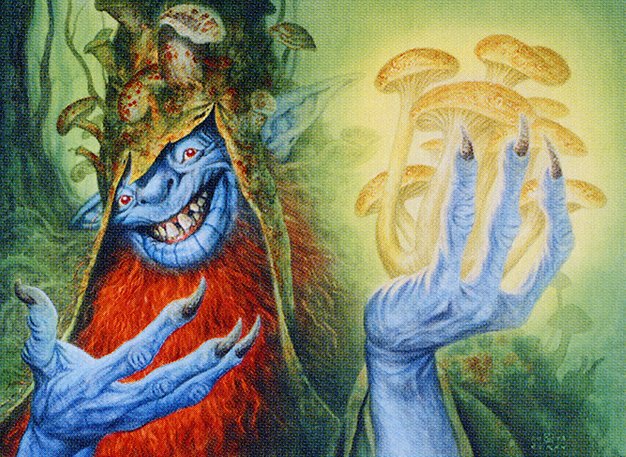 Art by Milivoj Ćeran
Art by Milivoj ĆeranOverview
As the name suggests, this cube is a Peasant list. For those unaware, “Peasant” refers to cards that have been printed at the common or uncommon rarity level. As such, I allow any card that has been printed at those rarity levels in any set - including online-only sets like Vintage Masters or whatever the latest Commander set is.
Additionally, I have made the decision to allow rare lands for the purpose of mana-fixing. The current exceptions to this include ABUR Duals, Fetchlands (I find these both unnecessary), and other dual lands with additional effects like Celestial Colonnade (whose uses extend beyond mana-fixing). This level of fixing allows for solid 2-color decks on average, with generally easy splashes into a third color when players wish to do so. Mono-colored decks are also viable, but much more rarely drafted. Aggressive decks need not worry about choosing between a tapped land or a creature on turn 1, which I think is healthier for the format.
Finally, I play with Snow Basics. What this means is that I also play with cards such as Icehide Golem or Winter’s Rest that require snow mana to be cast or snow permanents to be effective. I do not find snow to be a huge boon or burden for my cube and it could be easily cut if I felt like accepting the fact that I wasted 80 bucks on snow basics (Hint: I don’t want to accept that).
I find that the speed and power level of my list sits on the high end of peasant cubes. This high power level is something I’m quite proud of, as I often have heard the complaint that peasant cubing is “boring”, “slow”, or “weak”. I’m here to disprove those individuals and show them that playing without rares and mythics can be just as much fun as playing with them. Decks built from this cube tend to go no higher than 4 Mana Value unless they are Control or Midrange/Ramp builds, and I’ve even seen aggressive decks go no higher than 3 mana! And if you think Peasant is just about creature combat and curving out, I know some infinite combos and turn-2 Eldrazi that want to have a word with you.
All that said, I have a limit on what I think is safe and fun for my cube. Let’s talk about the banlist.
Banned Cards
As with any cube, there are cards that meet restrictions while remaining drastically outside the power level, resulting in poor drafts or game play. The following are cards that I have found to fit these qualifications:
Lotus Petal
Ancient Tomb
Mana Vault
Mental Misstep
Sol Ring
Mana Drain
Skullclamp
Grafted Wargear
Many more veteren players may see some cards they feel should be included in this list. Some examples of these can include, but are not limited to: Palace Jailer/Fall From Favor/Monarch in general, Reanimate, Strip Mine/Wasteland, Narset, Parter of Veils, Demonic Tutor, Gitaxian Probe, or Arcum’s Astrolabe. All of these cards are ones with high power levels and are always in consideration for bans. However, as of now I do not find them to be so egregious as to warrant their removal.
Archetypes Per Color Pair
I see no reason to reinvent the wheel here, so I’ll go over the supported archetypes in traditional color pair order. The following archetypes are not the be all, end all of what the color can do, but they are what the average deck of those colors will focus around. There is also the potential to see these particular archetypes spread to other color pairs, or go three-color. This is normal and a choice that I made when designing the cube to allow for less “on-the-rails” drafting.

 - Fliers, Aggro, Tempo, Control
- Fliers, Aggro, Tempo, ControlDecks composed mostly of blue and white cards will typically revolve around evasive creatures - typically with flying. Many of the token-makers in white are slanted towards making spirit or bird tokens in order to support this theme, and cards like Empyrean Eagle act as payoffs. Aggro decks and Tempo decks in these colors are supported by aggressive white one-drops, blue tempo staples like Man-o-War and Memory Lapse, and cheap white removal. Control decks in these color pairs can also flourish due to the large amount of counterspells and removal. White has an incidental lifegain theme to it that helps support control decks as well. Finally, a blink package that mostly consists of Ephemerate and Soulherder is included for players wanting to play for value.

 - Control, Reanimator, Ninjas, Tempo
- Control, Reanimator, Ninjas, TempoDecks composed mostly of blue and black cards will typically fall into either a creature-focused deck or a spell-focused deck. The creature decks will usually center around evasive creatures and “ninja” cards like Moonblade Shinobi and Ingenious Infiltrator that can give extra value to cards that have great enter the battlefield abilities like Ravenous Chupacabra or Baleful Strix. Spell-focused decks will usually play as control decks with win-cons such as Striped Riverwinde or Rise From the Tides, and they can also rely on Reanimator packages to finish out games early in a combo fashion, or later on as a value play.

 - Aggro, Aristocrats/Sacrifice, Control
- Aggro, Aristocrats/Sacrifice, ControlDecks composed mostly of red and black cards also tend to fall into creature- or spell-focused decks, with a much higher percentage of decks centering around sacrificing creatures for value with cards like Goblin Bombardment, Blood Artist, or Mayhem Devil. While recursive 1-drop black creatures are non-existent in Peasant, the decks can still function by relying on the reach provided by cards like Bastion of Remembrance and Burn spells. A dearth of solid black removal spells and board wipes like Golden Demise and Slice and Dice allow creative drafters to build control decks in this color pair and to finish out games with a timely Gurmag Angler or Archfiend of Sorrows.

 - Midrange, Persist Combo, Ramp
- Midrange, Persist Combo, RampDecks composed mostly of red and green cards trend towards midrange close to 100% of the time. Oftentimes, you are looking to play turn-1 mana elves into turn-3 threats, but the decks can also settle into a more traditional 1, 2, 3 creature curve with red’s aggressive low-end. Green-heavy decks can skew towards active ramp decks that splash red for burn spells to take care of aggressive opponents. Finally, the RG section is the first - and the primary - color combination to support the Persist combo. This combo consists of having Kitchen Finks or Murderous Redcap on the battlefield with a free sac outlet such as Goblin Bombardment, and a card that places a +1/+1 counter on the creature when it persists, such as Renata, Called to the Hunt, or Grumgully, the Generous. This combo can allow for infinite life or infinite damage on the spot.

 - Midrange, +1 Counters, Lifegain, Persist Combo
- Midrange, +1 Counters, Lifegain, Persist ComboDecks composed of mostly green and white cards primarily focus on being a midrange deck that has a synergistic focus around +1/+1 counters, lifegain, or both. Cards like Trelasarra, Moon Dancer and Conclave Mentor act as good bridge-gaps. Decks in these colors are primarily looking to go bigger than the aggro decks in the cube and mitigate their incoming damage. Many cards exist in these colors as “payoffs”, such as Abzan Falconer and Herd Baloth for counters, or Angel of Vitality and Honor Troll for lifegain. Finally, there is potential to make the Persist combo work in GW with the addition of Good-Fortune Unicorn and a colorless sacrifice outlet such as Blasting Station.

 - Tokens, Aristocrats/Sacrifice, Lifegain, Control
- Tokens, Aristocrats/Sacrifice, Lifegain, ControlDecks composed of mostly black and white cards tend to focus on clogging up the board, removing the opponent’s threats, and then winning either via attrition or with mass sacrifice and various Blood Artist effects. The lifegain elements from GW are equally present in this color combination, with various payoffs in the form of Indulging Patrician or Marauding Blight-Priest. Many of the most efficient sacrifice-based decks are made using a combination of white’s token makers and black’s great sacrifice outlets. On the other hand, black and white are the colors with the strongest removal options. This, combined with incidental lifegain, means that BW is a combination that can look to play a control deck.

 - Spellslinger, Control, Tempo, Mill/Self-Mill
- Spellslinger, Control, Tempo, Mill/Self-MillDecks composed of mostly blue and red cards are almost always spell-centric, with multiple payoffs for playing a large amount of instants and sorceries. Some examples of these payoffs include Saheeli, Sublime Artificer, Young Pyromancer, Murmuring Mystic, and Crackling Drake. Having access to plentiful amounts of spot removal and counterspells, these decks almost always tend to act as control decks. However, an aggressive slant is supported with cards like Sprite Dragon. Lastly, Mill and Self-Mill are supported as viable win conditions utilizing Laboratory Maniac and Psychic Spiral as key pieces. Most UR control decks look to win by having access to one of these cards, though more traditional means of victory via control are still available.

 - Midrange, Lifegain, Reanimator, Aristocrats/Sacrifice, Persist Combo
- Midrange, Lifegain, Reanimator, Aristocrats/Sacrifice, Persist ComboDecks composed of mostly green and black cards trend towards midrange builds that win via attrition, much like BW decks. However, the difference is that while white cards allow the deck to go wide and combo out, green cards provide more value in replaying them with cards like Eternal Witness and Exhume. Getting repeat value off creatures like Phyrexian Rager, Reclamation Sage and Sakura-Tribe Elder can allow a GB deck to win the long game. GB also has many cards looking to take advantage of gaining life, such as Blood Researcher or Dina, Soul Steeper. Payoff cards such as these can allow the player to turn inevitable victory into a decisive one. Lastly, both traditional “go big” Reanimator and the aforementioned Persist Combo decks can be built in this color pair - Pelakka Wurm is one hell of a card to bring back.

 - Aggro, Tokens, Equipments-Matter
- Aggro, Tokens, Equipments-MatterDecks composed of mostly red and white cards are the quintessential aggro decks that are needed to keep the rest of the decks in check. You are the fun police, and you’re looking to curve out early and end the game quickly. This color pair brings the highest number of low to the ground aggressive creatures and can back them up with cheap white removal and red burn spells for reach. Furthermore, these decks can utilize cards like Danitha Capashen, Paragon, Bruenor Battlehammer and Valduk, Keeper of the Flame to increase the already potent board presence that equipment cards can provide. Finally, cards like Intangible Virtue and Heroic Reinforcements can quickly spell doom for opponents once a wide enough board is established.

 - Midrange, Ramp
- Midrange, RampDecks composed of mostly blue and green cards are probably the least “deep” of the color pairs, but don’t let that fool you. UG decks can be some of the scariest midrange or ramp builds that come out the cube due to their access to card selection and advantage, counterspells, and viable top-end ramp targets like Striped Riverwinder and Plated Crusher. On top of that, cards like Moritte of the Frost and Trickster’s Talisman can quickly turn a scary game into an unbeatable one for opponent’s once they start having to face down multiple Waker of Waves or Sifter Wurm.

